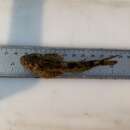pms
nòm ant ël fil


Cottus confusus és una espècie de peix pertanyent a la família dels còtids.
És un peix d'aigua dolça, demersal i de clima temperat (50°N-42°N).[4]
Es troba a Nord-amèrica: conca del riu Colúmbia al Canadà (la Colúmbia Britànica) i els Estats Units (Montana, Idaho, Washington i Oregon).[4][7][8][9][10][11][12][13][14][15][16][17][18]
La seua esperança de vida és de 6 anys.[19]
És inofensiu per als humans.[4]
The shorthead sculpin (Cottus confusus) is a species of fish in the family Cottidae. Shorthead Sculpins are bottom-dwelling small fish, typically sizing around 13 to 15 cm long. They have large heads and fanlike pectoral fins. They have 7-9 dorsal spines, 15-19 dorsal soft rays, and 10-14 anal soft rays. Narrow caudal peduncle. Palatine teeth and coloration being dark brown and yellow.[2]
It is found in the United States and Canada, inhabiting the Columbia River drainage in Washington, Oregon, Idaho, Montana, and British Columbia. It is also found in the Puget Sound drainage of Washington and in California[3] They will inhabit water where the temperatures range from 15.5 °C to 23.9 °C. The fish reaches a maximum length of 15.0 cm.[4] They will reside in rocky riffles of cold, clear streams, and occasionally lakes. They are benthic, sedentary, and nocturnal. Shorthead sculpin inhabit cold and cool water streams embedded with gravel-rocky substrates[5].In Idaho they are found year-round, while in other regions found primarily in the spring.
The shorthead sculpin diet resembles the same as other sculpins. They are benthic invertivores meaning they eat primarily aquatic insects, small fish, or trout and salmon eggs. They will spend the days hiding under rocks and then at night prey on the small invertebrates making them nocturnal hunters.[6]
Reproduction- Females reach sexual maturity around two to three years and males two years of age. Spawning occurs in the spring when water temperature ranges from 8 to 15 degrees Celsius. Sculpins are nest builders. The males will prepare a nest which is typically built underneath rocks. The female will lay the eggs and then leave and then the male fertilizes the eggs. The male stays to guard and care for the eggs.[7]
Conservation status of these fish are least concern in the United States. Main threats to the species are extended periods of low flows and runoff from mining and industrial activities. Another threat is non-native species. Researchers have found that Largemouth Bass, Walleye, Yellow Perch, Northern Pike, and Pumpkinseed pose a moderate to high ecological threat to the Shorthead sculpin.[8]
The shorthead sculpin (Cottus confusus) is a species of fish in the family Cottidae. Shorthead Sculpins are bottom-dwelling small fish, typically sizing around 13 to 15 cm long. They have large heads and fanlike pectoral fins. They have 7-9 dorsal spines, 15-19 dorsal soft rays, and 10-14 anal soft rays. Narrow caudal peduncle. Palatine teeth and coloration being dark brown and yellow.
It is found in the United States and Canada, inhabiting the Columbia River drainage in Washington, Oregon, Idaho, Montana, and British Columbia. It is also found in the Puget Sound drainage of Washington and in California They will inhabit water where the temperatures range from 15.5 °C to 23.9 °C. The fish reaches a maximum length of 15.0 cm. They will reside in rocky riffles of cold, clear streams, and occasionally lakes. They are benthic, sedentary, and nocturnal. Shorthead sculpin inhabit cold and cool water streams embedded with gravel-rocky substrates.In Idaho they are found year-round, while in other regions found primarily in the spring.
The shorthead sculpin diet resembles the same as other sculpins. They are benthic invertivores meaning they eat primarily aquatic insects, small fish, or trout and salmon eggs. They will spend the days hiding under rocks and then at night prey on the small invertebrates making them nocturnal hunters.
Reproduction- Females reach sexual maturity around two to three years and males two years of age. Spawning occurs in the spring when water temperature ranges from 8 to 15 degrees Celsius. Sculpins are nest builders. The males will prepare a nest which is typically built underneath rocks. The female will lay the eggs and then leave and then the male fertilizes the eggs. The male stays to guard and care for the eggs.
Conservation status of these fish are least concern in the United States. Main threats to the species are extended periods of low flows and runoff from mining and industrial activities. Another threat is non-native species. Researchers have found that Largemouth Bass, Walleye, Yellow Perch, Northern Pike, and Pumpkinseed pose a moderate to high ecological threat to the Shorthead sculpin.
Cottus confusus is een straalvinnige vissensoort uit de familie van de donderpadden (Cottidae).[1] De wetenschappelijke naam van de soort is voor het eerst geldig gepubliceerd in 1963 door Bailey & Bond.
Bronnen, noten en/of referenties短頭杜父魚,為輻鰭魚綱鮋形目杜父魚亞目杜父魚科的其中一種,為溫帶淡水魚,分布於加拿大卑詩省、美國蒙大拿州、愛達荷州、華盛頓州、奧勒岡州淡水流域,體長可達15公分,棲息在岩石底質、水溫低的急流,生活習性不明。